Chapter 9
Of Water
WATER is defin’d (by the Antients) an Element most cold, and humid, (or Moist) Air (by them) was Said to be most Humid, and yet (say they) water [humoctates] ([or] moistens) more than Air because of its more crass parts whereby it better adheres to the thing to be moistened. Its natural motion is downwards. Its place between the lower surface of the Air, and the Upper of the Earth, which it would all naturally cover, but that for the Use of Animals which need Air for their lives, the Earth in some places is made permanent; as Sustayned by Rocks, and So Emergent into the Air; and the water in other places is reduced into hollows, and Channels fitted to receive it.
N.B. Hence Seams to be a confusion of Humidity, and fluidity which indeed are distinct Qualityes; or at least a Humid is a fluid with an addition of adhering clammy parts, and then we may say Air is most fluid and water most humid, but that will not admit humid to be a first Quality nor will Aristotles combination of the 4 first Qualities Clinck well in finding out the true number of Elements, we may therefore conceive water to be moist, and cold, and leave Air to be most fluid.
But leaving these conjectures of the antients we shall count the attributes of water primary 3. Quantity, Fluidity, and Gravity; and other Secondaryes that arise from them.1
1. Quantity or Extension of Water is either Superficial or bulcke.
1. Superficial which is Especially taken notice of in the Sea; the Proportion of which to dry land is observed by Geographers, and the measure is taken of it by Mariners with a Logline [and] a Minute Glass, (the Logline is a small Whipe cord of divers fathoms long haveing at each fathoms end a knot, and [small] bitt of Cloath or rag of Several collours; one End is fastened to a peice of board, 18 Inches long, and 6 broad; the other end with all the length is round a rundle that runs round a Spill:) Now the Wood or Log being Cast out at Stern is Supposed to keep its place in the water whille the Shipe passing on draws of[f] the line from the rundle; How much goes off whille the Minute Glass runs is observed; this multiplied gives the Number of fathoms in an hour or watch (which is 4 hours) when they Usually heave the log (as they Express it) that is repeat the trials of what course they run; by this with the observation of Lon-[25]gitudes, and Latitudes they discribe the surface or compass of the Sea upon their sea Carts plats, maps, and Globes, as we have it
2. Bulkie as the 3 dimensions; this is Judged of by the Dimensions of the contayners, which we call fluid measures, as a Pint, Quart, [etc:] or by the Weight [of the bodies] contayned in the measures So a Pint is one [lb], a Quart 2 [lb], etc.; or Dimension and weight Compared; So a cubical foot of fresh Water is = to 72 [lb:] Salt watter = [lb:] 73½. to Know the Quantity of stagnant or Pool-Water is therefore easy Enough; but the Quantity of running water is to be measured by Velocity instead of length in a determinate, and known breadth, and depth: this done by an Instrument cal’d a Regulator (that is a long trough shuch as are at overshot mills,) and a Pendulum of 3 foot 7 Inches (or 43 Inches) which Vibrates a true 2d of time (that is a 1/60 of a minute) Now if you put water to run through the regulator (which shews the breadth, and depth) and put a Chip or Cork to float on the water, and at the Same time move your pendulum, you thereby get the length in so many 2ds of time: If you then also receive the water [at] the falling Vessels either the Whole Stream, or any [one] part of the Stream Equally divided into what number of parts you please (say 3 [as] in the Diagram whereof one is saved in the Vessel) now by the measure of these receiving Vessels, in such a time (say [10] 2ds) compared with the breadth, and depth of water in the regulator it is easy to compute what [quantity of] water passeth in a minute, hour, Day etc: In such a regulator so far fill’d, and in such a declivity. By this also you may Judge of the Quantity that passes in a large river by comparing the Dimensions of this Small Regulator to those Dimensions of a Greater set up in a River like one or more door frames through which all the Water [of] the river must pass. Now the Velocityes of Each of those frames being taken by the Pendulum and the same Velocityes being examined by the small regulator you may Easily by Computation know what is in the whole river by the proportion it bears to what is in the little regulator. If the bottome of the river be uneven and the Velocities of the sides, and middle be different; yet the computation willnot be much more difficult. This will be of great Use in all manner of Aqueducts; for hereby you will know what Quantity of water every Channel with every degre of Declivity (and velocity by consequence) will carry.
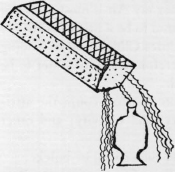


Surface by Logg and minute glass is known
Bulck by a trough, [and] pendulum is shown.
2. Fluidness or aptness to spread, and insinuate itself among the smaller parts of another body apt to receive it. Now many bodyes are not apt to receive it, but do oppose it. And about this disinclination various arts are Exercised, partly to make advantage of it, partly to Subdue it. The Bodyes that refuse a Mixture with water are all fatty Substances, as Tallow, Oyle, Grease, etc:; and all Cerasious, and Recinous bodyes; as bees-wax, Pitch, Tar, etc: the advantage made of their keeping out water is their being applyed to Ships and boates in their hulls, and Tackles; also Oyling, Waxing, [and] Liquoring of leather; as in boots, Shoes, etc: The Subduing of this reluctance (that by water these, and the like things may be servisable to us) is gotten by divers usefull arts which have been found out whereby these things so averse to water in themselves may yet by Somthing of a middle nature become Sociable therewith: This Middle thing is Salt which is a mean between Earth, and water partaking Somthing of the nature of both. The Earthy parts of it will mingle with Earth, as being congeniall with it; and the Watry parts of it will disolve in water, and So associate themselves thereto and yet are not those Earthy, and Watry parts So seperated but Still they have an aptitude, and Inclination to conjoyn and [so] fasten all togather this is the Ground of many domestick opperations; as making Soape, Washing, Brewing, Baking, etc [26]
1. Making Soape wherein Water and Oyle, or Tallow concorporate by the help of Potashes, and the Salt of lime. Potashes is an Alcaly or salt of Vegitables made of the Lee of Wood-ashes and has in it a Good Quantity of Sulphur, or fatty Substance; therefore care is taken in the making thereof that the Infused brushwood when it is to be burnt do not flame least the Sulphur be consumed, and hence it is that it smeals like Gunpowder in which we know Sulphur has a considerable interest; The Salt of lime gives fixation to the potash which otherwise would be too Volatile for this purpose when the vehement heat of fire should come thereto.
2. Washing is a Using this Soape as a mean whereby water can mingle with the Greasy foulness of cloaths; and then by its weight falls of[f] and carryes the greasy filth with it. Yea Some Sharp Salts free from Sulphurious parts do peirce and work upon Gums, and Resinous bodyes; as Sharp Viniger Juice of Limons, and Spirits of Vitriall; and some Earthy parts, (as [in] fullers earth) do mingle with clammy bodyes, and get them off. But all these opperations do need agitation by fire handy labour or both togather. Firey particles do enter and open bodyes and So give passage for water to follow them. Beating [or] rubing also do thrust in parts of water by Violence therefore both are commonly Used in Washing.
3. Brewing proceeds on the same Ground for the fire opens or melts the oyle of Malt, and mingles the body of water with it. Then the bitter and stippicall salt, and Sulphur of Hops binds them both togather till there begins a Quarrel between the Grosser and unapt parts of Sulphur, and the water with which they cannot mix, and then in the fermentation they are cast of[f] in the barm.
In Ale the forementioned fermentation is Sooner, because there only the heat of the water hath attempted their Union which is not So firm as by the Stiptick hops In the mean while the tenuious, and more Volatile parts do remain concorporated with the Water, being fine enough continually to permeate all its pores, and the Vessel being well stoped Suffers them not to Evaporate and fly away: Therfore they continue their motion Every way in the body of the Liquor this is cal’d the life and Spirit of the beer. But if in the perpetuall Agitation they meat with any Groser parts not before cast off; some of them [they] attenuate [and joyn] to their own bodyes; others (that are inseperable) they precipitate to the bottome where they attain the name of Grounds.
N.B. Tis therefore profitable not to take off too much of the barm, nor to Suffer it too long to work that way.
4. Elixation or boylling of meat is of the same nature for the Water helped by the fire gets in among the parts rarifying some, and Seperating others which are of insuperable [crudity].
5. Making of bread where[in] water by stirring and kneading gets in among the flower, and causes them to adhere, (not by Clamyness communicated; for that the Water has not; but) by filling all Cavyties, and So rendring the parts polite one to another whereby they stick togather as polished [marbles do]; hereby the Volatile parts or Spirits of the flower are retayned even when they are put into motion by the heat of the Oven; they therefore rayes and swell the Mass, and the parts of water rarifyed do mingle with these Spirits, and help to fill the caverns which the raysing hath made, and their Embod[y]ing with the bread do render it more apt for our nourishment, and thus for its fluidness.
Water ’mongst other parts itself doth spread,
Hence fit for washing, Making Soape, beer, bread
[3.] Gravity of water is whereby it hath a tendency downward and gives a pressure to what is under it; this is either absolute, or comparitive.
1. Absolute; and so one Pint is [ac]counted [lb:] 1. a Quart [lb:] 2. A Gallon [lb:] 8. a Cubical square foot of fresh Water [lb:] 62; of Salt[water] 63½ a tun of fresh water 20 C: Lees or Lixiviums exceed water according to the solution of Salt in them, because salts are hea[v]yer than water; from this (and Fluidity as a notable secondary affection) arises the motion which is every way one way or reciprocal.
1. Every way call’d flowing, when any parts of water are raised higher than any thing besides it that should contayn it; then because of its [fluor] it contaynes not itself, and because of its weight it fals and runs about any way that it can til its Surface be reduced to Equality. Hence [where] rivers by accession of waters are raised above the banck they overflow the meadows.
2. One way, and this is either natural or forced.
1. Natural by Each parts proper Gravity, as in rivers and fountains whose [27] lower water falling away (having no impediment) do leave space for higher waters to fall after them. This is augmented or decreased by Velocity according to the declivity of the bottome (cal’d the fall) and the rectitude or curvity of the Channel. These in Natural Currents are accidentally varied according to the hardness or softness of the Ground where it runs; hence deep pooles being slow; and Shallow streams swift, [are] So convenient for the breed, and nourishment of fish. But in artificial derivations; whither draynes, and conduits where the design is to draw as much water as posible the Channel shoul[d] be straite (as may be) Shallow, and of Equal current. This preserves full Velocity, and Quantity, charges not the bancks, and Saves needless length, add to this to make water move forwards, at least one foot below the level of an Instrument must be allowed to every mile, in respect of the roundness of the Earth, and this being [d]educted you may account the rest Effectual fall. But of these things more elsewhere.
2. Violent, by pressure of other water, or other body.2
1. Of other Water hereby it ascends contrary to the nature of its Gravity, and therefore its ascent must be reckoned but as a passive power. This is the motion out through an hole in the side, bottome or top of vessel or in the [Smaller] End of a pipe turn’d upwards (as in the Diagram) whereby are made those springers in artificial fountains, here the rule is; the Switness strength, and Quantity is according to the depth, and weight. Thus if a Hogs head be set on its end, and 3 holes of equal bore be mad[e] in the side [as] at (a.b.c.) more liquor runs out at (b.) than at (a.) in the same time, and more at (c.) than at (b.). In a Ciphon inverted (or crooked pipe) water will ascend as much as it descends, to bring its surface equall, where is no other pressure than the water in (d.) to poyse up the water in (e.) both being within the pipe; but if the conical figure of the Discender be inverted (as in the Upper figure) then the pressure is augmented and the I the smaler end of the pipe according to the height of water in the Larger Cone; but then that never rises above the Surface of the pressing water, and parhaps it is allwayes somewhat lower.

2. Of Other bodyes, or powers, as compressed Air, or pounsells which may have Weight as those at the Water-house at London-bridge; or strength as by the Staff of a Water Engine, or springer; then will it fly much higher than the common surface, as we may see in the Engines made for Quenching of fire, and other devises by Water Wheeles or Wind Wheeles to force up water for the Use of Cityes. But all those things are Chargeable, and lyable to breach and wearing; therefore conduits of water (where they may be had) are more Eligable; for nature directed to serve our occasion will rather comply than yeald to any force. But of all such Engines the Water Screw3 appears most admirable, in which the water seams to ascend by discending (and So it would be referred to the former motion of proper Gravity) but indeed it is impossible for water to ascend above its primary surface without a force; It is done therefore by a mixture of force, and Inclination but force has the Cheifest hand therein; for the turning of the Engine Screws up the surface of the water and then the body of it follows so that in every round it lifts up the water so much as the one round is above the other, and whereas the water in the Screw is alwayes running downwards that is only to prevent its being lifted up by any part of the fixed pipe, but that which is directly under it. This sort of lifting may be illustrated by a little water standing on a trencher one side of which being a little raysed up puts the water a running to the other side and so to run off the table; yet if before it run of[f] you raise the other lower side a little, and at the same time raise ano-[28]ther by-side of the trencher, you’l find the water will not run over, but turn aside as the declivity is varyed. Now this lifting up in the Screw is continued wherein the Motion of the parts of the Pipe upwards dos anticipate the motion of the Water downwards, and so snatch it with them ere it can remove out of the Way. They moving first and faster than the Water, must needs therefore get Ground thereof. This is a thing of very curious consideration, and requires some skill in Mathematical Mechanicks to apprehend it. And thus much of the motion of water one way, and every way now of reciprocal.
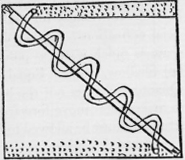
3. Reciprocal motion of water is a proper affection of the sea (wh[i]ther we shall referr it) only note it here as a species of waters motion. And this of absolute gravity.
|
2. Respective Gravity of Water is the same [compared] with |
|
the Atmosphere. |
|
other Liquors. |
||
|
Solid bodyes. |
1. The Counterpoyse of Water to the Atmosphere is 32 foot more or less (i.e.) a pillar of the Atmosphere from top to bottom will press water into pipe 32 foot high; therefore we cannot make water [by Succion] in a Cyphon (or pump) to rise higher than the 32 foot perpendicular for beyond that it will leave a vacuum (or only Ether) rather than rise (as in the Torricellian experiment before noted.) And hence it is if the Upper surface of water in Wells lye deeper than 32 foot men are forced to make double Pumps; as, Suppose the other surface of the Water at (a.) be 60 foot under Ground, you’ll need two pumps, one to draw it 30 foot from the surface (a.) to the Cystern (b.) and in that Cystern to plant another pump to draw it [up] 30 foot more to the bucket (c.) for your Use.

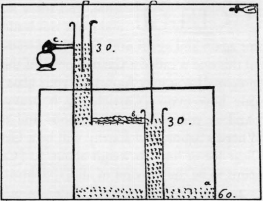
2. The Counterpoyse of Water to other Liquors; as Milk, Beer, Wine, Brine, Mineral waters, etc: this is according to the Mixtures or solutions of other bodyes in the liquors which are more heavy than waters, these must be Earthy or Saline parts; for Spirituous, and Sulphurious are lighter than water; the discovery of this may be of Great Use, and delightfull curiosity, and this is done by the say-Glass (heretofore accounted a Great mystery, but) Now of common Use with soap boylers, and potash-men, to know the strength of their lees; Take the fabrick of it thus: Get a small Scale, and a Glass-bottle of any Quantity (say ½ a Pint or thereabout) to counterpoyse it in the scale by a thin plate of lead (say as thick as a Crown peice) whereon set the Letter (G.) signifying that this is the weight of the Empty Glass. Then fill the Glass with the Clearest fountain water and put [it] in one scale, and the Glass weight in the other; also add to this weight (G.) another weight which with that of (G.) will be Equipoyse to the full Glass and therefore this [other] added weight will be Equall to the Water, and let it be marked on the [one] side (W.) and on the other side (64). This last weight (W.) is to be divided thus. Put it into one scale, and in the other its equal weight of Sand; having Done this remove the (W.) out of the scale and put in its place ½ the sand which you may do by removing a little of it, [on] the poynt of your knife from scale to scale till they be both even then cast away the sand out of on[e] scale, and fitt a lead equall to the remaining half, and mark this lead with (32.) in like manner divide this again and again untill you have leads marked (64, 32, 16, 8, 4, 2, 1, ½,) this one is called a Carrick or 1/64 of the water weight things being thus [prepared] you may [now] fill your glass with any liquor, and see by the scale how many [Carricks] it is heavyer or lighter than water. [29] [And so you will find spirituous and oyly liquors lighter than water] Whereas Saline, and Earthy will be a Great many heavyer. I have seen a Clear lee of lime to weigh about 30 [Carricks] more than water; for it seams to be the heaviest of all l[i]xiviums.
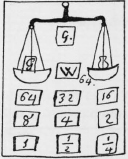
3. The Counterpoyse of water to other solid bodyes, such as Wood, Metall, etc: hence arises (as a Secondary affection) Navigableness or an aptness to bear up a body on its Surface, and also (by reason of its fluidity) a yeilding to its motion forwards, by any easy Movement (supposing there be sufficient depth) the reason of bearing up [is] the Equipoyse of so much water removed out of its place by the weight of the body lay’d thereon; as, Supose a Cubical square foot of water weigh 62 [lb:] then a Cubical foot of wood weighing 31 [lb:] will half [Immerse] or sink, and half [Emmerge] or swim above water, because its weight can remove but ½ a foot of water out of its place; hence it follows that salt water bears up better than fresh, because heavyer (as is before noted) and metals (though heavyer than any water yet) being shaped hallow (as a dish) may thereby be apt to remove more water than their own weight, and So Swim as well as Wood.

And thus much for the General affections of water Quantity, Fluidity, Gravity.
The principle parts of water are sea and fountaines.
1. Sea (or Ocian) [is] the collection of waters, Genesis. 1. 10. it is an Integrall whole, and therefore has not Species, but integrant parts, which have their accidental denominations from their Quantity or adjoyning lands, as Main, Ocean, Creek, bay, harbour, [etc:] English sea, Irish sea, etc: of which mor fully Geographers its Cheif affections are saltness, and reciprocation.
1. Saltness concerning the Cause of which have been diverse oppinions.4
1. Some have thought it concreated with the sea; but then surely it could not so easily be seperated from the water as we see it may [be] by distillation, and other evaporations; as by the sun whereby bay salt, or by fire whereby other common salt is made
2. Others have thought it caus’d by the sunbeams drawing off the Sweeter parts and adusting the rest, but then the sea would be Salter in the summer than in the Winter which we find not; and besides there would be no sweat water in [hotter] countryes.
3. The most likely cause of it is the solution of Salt Peter, or other salts of the Earth which it continually receives partly by washing submarine peter-rocks, and partly as the common sink after rain receiving all the filth of the Earths Surface wherein there is abundance of salt. Nor nead we fear the sea should hereby [at last] exceed in saltness, because as it dayly receives, so it dayly imparts its saltness when it insinuates itself into the caverns of the Earth to become the Matter of fountains; Where it percolates (or straynes) well, the salt is lodged in the Earth. The more fixed parts to be subservient to Mineralls, the more Volatile to arise and become the salt of Vegitables; but where it has free passage, and straynes not, it makes salt fountains such as we find at Nantwitch5 and the places thereabouts, there can be therefore no stagnancy of salt in the sea, seing it has its circulations through the Veigns of the Earth.
2. Reciprocation or Ebing, and flowing whose End, and Efficient.
1. End that it may better serve Navigation, and (say the Antients) least the sea should putrify [but] how is it then that the Greatest part of the ocean [having] no tides dont stink us out of the world.
2. Efficient Was antiently Guessed to be the moon whose motion the sea was said magnetically to follow, other[s] ascribe it to the pressure of the moons rayes on some part of the sea and thereby forcing it to rise in others. This Regency of the moon and relation to the sea was Supposed, because the spring, and Neap-tides keep time with the full and new moon, and so they fall into the fallacy of cause for not cause. But to say the truth the antients ware as much at a loss in this as in any part of Phylosophy; yea there is a traditionall story of Aristotle to be so much trubled at his Ignorance in this matter, that he threw himself headlong into the river Euripus, and drowned himself; Saying, (since I cannot [take] thee, take thou me) After he had stood poring long on this p[h]aynominon, (of the Ebbing, and flowing) and could obtain no Satisfactory account thereof in his thoughts, but since the Copernican scheme hath [obtained] some credit in the world, there is an easy, and natural way thereby to solve these appearances, which we shall breifly explain The P[h]aynominon of tides are either common, and natural; Extraordinary, and Accidental.6
1. Natural are the reciprocations in the 3 Periods Diurnal, Monthly, and Anuall.
1. Diurnal twice in 24 houres, that is Ebbing 6, and flowing 6, or about ½ an hour more in every tide. In this are 3 varieties, Rise without currunt, currunt without rise mixt of both currunt and rise
2. Monthly a Gradual increase and decrease in height and greatness of the tides every fortnight, [30] [called Spring and Neap Tides.]
3. Annual Augmentation of these springs and neaps about the Solsticial points or soon after the longest and shortest dayes, the Springs are highest, and the neaps lowest and about the Æquinox when the dayes and nights are Equal Spring[s] and neap[s] are of less Quantity.
N.B. These times are taken out of Galleleus But Dr. Wallis observes and assigns other times and reasons after another manner (or Sort) concerning this matter as may be seen in the Appendix after these Physicks.
2. Accidental are variations from the Common periods by the Scituation and figures of Channels, depths of water Stormy winds, Nearness of vast Oceans, which give either movement or impediment, and hence arises Effects, some more constant as the mentioned currunt, Rise of water, some altogather uncertain, as Extraordinary floods, [and] Doubling tides.
Tides natural are in a Day, Month, year;
Tides accidental variously appear
Now to find out the Cause of all these from the copernican Hypothysis Comparison is made [of] the sea to [the] Water that may be contained in a Vessell; for Channels, and lower or hallow parts of the Earth are but Greater Vessels capable of Greater Quantityes of Water The Reciprocations they compare to the Greater Swayes of a Pendulum wherein some outward cause at the first (say a mans hand) brings the bullet to its height, but afterwards its fall is back again, and continued to swing by its own weight; in like manner dos water being forcibly raised up by one side of a Vessel, through its own weight, and fluidity fall back again, and So continues to sway from side to side. Now the Motion of the Vessell may Cause the Water to Ascend by one side, by altering either its Site or Velocity.

1. By Altering the site of the Vessel (as in the figure a.) inclining it to one, or other side, and then the parts of the bottom must be altered in their Distance from the Center of the Earth, (or of Gravity) which presently causes the fluid water to flow toward the lower part: But the bottom of the sea can never have its distance thus altered, and therefore this way will not serve our turn.
2. By altering the Velocity of the Vessell[s] motion from rest (or slowness) into motion (or swiftness,) and on the Contrary from Swiftness into slowness; either of these will cause the riseing of the Water, at one, or the other end of the motion, as, Suppose a boat carryes a long trough of water [placed] according to the length of the boat, and the trough be fastened thereto, If the boat be thrust off from the shoar where it rested after the prow, the trough will immediately have the same motion, because fastened, and Solid; but the Water being lo[o]se and fluid will not presently take the Motion, but linger a little behind in the state of rest wherein it was before; therefore the trough going on from under it (as boys strick out the neithe[r]most of 2 Groats laid on the top of their thumb,) must leave water to heap and [so] rise in the stern by shuffling the former, and hinder water togather; but here it will not rest; for when it is risen as high as it may towards [the stern by] that motion of the trough it falls away again forwards, towards the prow by its own Gravity and So by degrees comes to a forward motion equal to that of the boat. and then keeps on in the same velocity with it. But in Case the boats course be retarded, or stop’t, the Water dos not presently retard, or stop with it; because of the lo[o]seness and fluidity before noted therefore the water continuing the same velocity for a While, it must shuffle parts togather and rise at the prow as it did before at the stern.
Now in the Copernican Scheme the Earth trolling itself roun[d] its own Axis (as a bowle) in the Diurnall revolution, and withall round the Great orb ascribed to the sun by Ptolomie (as it ware the length of the Green) in the Annuall revolution, the Center of the Earth runing in the line of the Great orb; therefore the superficiall parts of the Earth must needs have an [unequall] Velocity; for any one part (Say the meditarenian) must somtimes move forwards (from west to East) with a double Velocity namly that of the Diurnal revolution Superadded to that of the Annuall, as appears by the Diagram. Suppose the great Circle [be] the Grand orb, or Eccliptick (in whose Center is the sun) the less Circle is the body of the Earth (whose Center (c.) moves in the Eccliptick onwards from the place (c.) [to] K.L.M. etc: mean whille turns (a) round by (b.d.e. etc:) 365 times,) Suppose also the Place between (a. and e.) is the meditarenian sea; [31] Now (a.) the Superficial part of the Earth between (4. and 1.) hath its motion concurrunt, or the same way with the Center (c.) therefore while it passes in that distance the Superficial (or Diurnal) Motion must be added to the Central (or Annual) while (a.) is moving between the points (1. and 2.) it neither adds nor diminishes, because it neither goes forward with, nor backwards against the annual motion, but only downwards from (1. to 2.) as on the other side it goes upwards from (3 to 4) therefore while it is passing these two distances the Motion of the Superficial point (a.) is only the same with the Center (c.) in the Anual Course, but whille (a.) moves between 2 and 3 it goes backward, [and] contrary to the Annuall motion; therefore you must Substract from the Annual so much as the diurnall motion shall in that while be. Now you must note that the Velocity of the Annual motion is 3 times [Greater than] that of the Diurnal; If therefore you call the Diurnal motion[s] Velocity 1 Degree; then the Velocity of (c.) is 3 degrees to this add one and that is 4, or from this Substract one, and it is 2 Degrees; so then the point (a.) Or the meditarenian (a, e,) moves 4 Degrees of Velocity between the Points (4, and 1,) 3 Degrees between, (1, and 2,) 2 Degrees between (2, and 3) 3 Degrees again between (3. and 4) etc: From hence twill follow that the Sea of a long tract (E, and W) and near the Equator where the Superficial parts move in the Greatest Circle must have the Greatest tides because [in] them [is] the Greatest [diversity] of motion whereas Seas nearrer the Poles, and lesser Circles and Such as have but one or two degrees E. and W. Longitude, also seas [but] of Such a breadth though they have a long tract N. and S. (as the red sea) have not sensible tides at all; because the reciprocations are so frequent that the flux, and reflux from shore to shore, do interrupt and break the course of one another, it follows also that far out in the ocean can be no tides because the reflux from the shore runs not so far out, before there is occasion for a new tide at the Shore.—Moreover in long, and narrow seas, especially nearest the poles where the Circles of their motion [are] not so great the flux may be at both ends at once, for one End may be [in] swiftest motion, when the other may be in slowest because of the length of the Channell. Lastly it follows that tho tides in the sea run (East and west) yet in rivers, and bayes it may [flow] N. and S. or any other point because of the course of the rivers; So in the sea between England, and France the tide is E. and W. But in [Southampton] river, and [in the Sea] between England and Holland it flows N. and S. and in the Thames it flows west at the same time [when] it flows East at Dover; because the rising waters of the sea rushes into the rivers and streights which way soever they lye; as for the doubling of tides, and uncertain Great overflowings, it may be from the suddain sea-storms interrupting, and precipitating the tides natural course and from Great land raines increasing the waters of the rivers
P[h]ainominon of tides hath its Solution
from Earths Swift, Slow, unequal revolution.
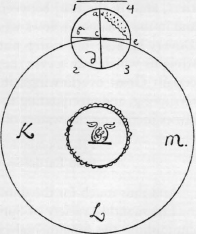
And thus much for the diurnal tides, and their Accidents.
The monthly variety of Spring and neap is solved in augmenting, and diminishing the fundimental cause in the Diurnall revolutions, for if in [divers] times of the Month its dayly revolution is accelerated, and retarded more than is before shown; then the Causes of the flux, and reflux being increased the Effects must be also increased accordingly. This alteration of the Earths revolution is by the moons motion round about it; not that the Moon has any thing particularly to do with the water but rather with the vessel which contains it retarding and accellerating motion therein according to its various positions in respect to the Earth. for (say the Copernicans) the Moon is by the law of nature oblidged to be still moving round the Earth at a Certain distance (as the New found attendants of Jupiter do dance about its body and accompany it about its revolution) so that the Earth and Moon togather make as it ware but one movable about the Grand orb, or Eccliptick; hence it comes to pass that somtimes the moon is farther from the sun, (the Center of the Eccliptick) than the Earth so far as the dis-[32]tance is between the Earth, and [the] Moon now the Moon keeping the same course about the Earth [yet] ridds less way onward under the Eccliptick when it is farther from the sun because it then moves in a Greater circle whose degrees contain more miles, and therefore in respect to the Eccliptick, (or Annuall revolution) it may be said to be more slow, Now the Earth being nearrer might therefore outrun it but that it cant leave it behind, because of the Certain distance (before Mentioned) which must be kept between them; it therefore follows that the Earth must [then] linger, and slack its course when the moon laggs behind, that it may still have the Moons company, and (on the other hand) when the moon is nearer the Sun it Gets onwards more degrees in less time, because of the comparitive littleness of the Circle, and therefore may be said to move faster than the Earth which yet it cant forsake and by consequence must [pull] it on faster by the unchangeableness of the [Said determinate] distance; as, in the. Diagram, Suppose (e.) the Earth be moving its own course in the middle circle, (i.e. the Grand orb,) and (M.) the Moon be moving in its course round the Earth Suppose also the 2 Pricked lines make an angle of 20 Degrees in the Center of the sun you see this twenty Degrees is but a little way in the Inward circle at (c.d.) When the Moon shall come thither between the Earth and the Sun; but tis a Much Greater way to make up the 20 Degrees in a Greater Circle; as at (a.b.) about the place (m.) when the Earth is between the sun, and the Moon This is also illustrated by the weight of a Pendulum string; for if it be shortned the bullet move[s] Quiker than when let down to a Greater length; as suppose an hook struck in a Ceelling, and over it goes the string of a pendulum if you let it down no farther than from I to K. the Vibration[s] will be Quick, but if you let the bullet slip down so far as L. it will alter its pace and turn slower Now if there ware 2 bullets hung by one string (as in the former Diagram) where the Sun is as the hook (or Center of the motions) the Upper bullet represents the Earth the lower the moon, that nearer to the Center (the Earth) would move from (g. to h) but the remoter (the Moon) would hang back, and not be able to keep pace with the other, and though the nearer [bullet] (representing the Earth) be Greater, and therefore must overrule the motion of the less (representing the Moon) yet the less will some way retard the Greaters motion.
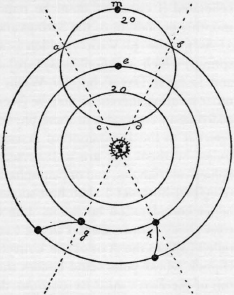
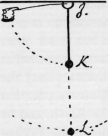
They also Illustrate it by two poises that hang on the fly of a large publique Clock; for if but one of them be removed farther off from the Center; as Suppose the weight (b.) be removed out of the notch (a.) which is farther from the Center (c.) than the Notch (d.) then the motion of the whole fly and by consequence of both the Weights appendents thereon will be retarded, (as on the Contrary) accellerated if either of them be removed nearer; and thus much of the monthly periods, or of the Springs and neaps.
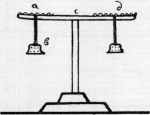
As for the 3d Variety which is annual, or the higher than ordinary springs, which (sais Galleleus) [are] about the solsticial points (or shortest and Longest Dayes) but Dr Wallis Says otherwise, and therefore gives other solution thereof as may be [seen] in the Abstract out of him, and is added as an Appendix to these physicks. But according to Galleleus they referr it to the Inclination of Axes; this is the hardest to be understood unless by them that are well versed in the Globes, and the doctrine of Sphærical triangles, and of planispharies else tis hard to make a diagram intelligible; however I shall hint something of it here, and leave it to your better consideration hereafter. The Copernicans say that tho the Earth roles about with its Center in the Eccliptick; yet it still keeps its axis parrallell [33] to the Axis of the Universe, and not with the Axis of the Eccliptick whose poles stand besides the others 23½ Degrees, therefore the roll of the Earth must be somtimes direct with the run of the Eccliptick; as when its Center is in or near the Solsticiall points; because then the Motion of the Earths Center is for some dayes, (as it ware) in the tropical circle whose Axis and poles are the same with [those] of the Universe, and in this state and place the revolution of the Earths Equator [is full] ½ [above] and ½ below the Eccliptick then the Prostapheresis (or the Addition [or] Substraction,) in respect of the monthly periods do import as much as the whole diamiter of the Earth can effect; but at all other times and most at the Equinoxes the Globe of the Earth is somwhat oblique, and move[s] sidewayes to the run of the Eccliptick [else] the Earth could not keep its axis parrallel to the Axis of the Universe; So that at the Equinoxial points (at or near G.) the Equator of the Earth, and by consequence the Course of the Earths Revolution is oblique to the Eccliptick [23½] Degrees and therefore the Edge of the Equator comes nearer the Eccliptick than when it stood upright by the 1/12 of the whole diamiter of the Earth. And by Consequence cuts off so much of the P[r]ostaphærisis; as, supose (in the Diagram) (A.D.) be a Segment of the Eccliptick, and (C.) the Earths Center in the Solstitiall point of the Equator (and Revolution) here the whole Diamiter (B.G) Playes above and below the Eccliptick; so that the point (B.) in the revolution of the Earth Dayly comes as low as (G.). But in the next Diagram where the Earths center is supposed to be in the Equinoxial point, the Equator, (and Revolution) of the Earth stands obliquely in (E.[E.]) here the mounting above and falling below is less, So much as the line (E.F.) is shorter than the line (B.C.) or Earths Semidiamiter: So that in the Solstaces is the Greatest P[r]ostapherisis or addition to [and] Substraction from the motion of the Earths Center in the Eccliptick, and in the Equinoxes is the least. Therefore (according to Galleleus) the Springs, and neaps, are Greatest in the solstaces, and least in the Equinoxes. The Intermediate Spaces (or times) are Varied according to the nearness, or distance of one of these cardinal points. Now all this that is said of the 3d Variety referrs to the seas, that [may be] under [or] near the Earths Equator, Where the Earths motion in Superficiall parts is Greatest. As for all other places their Annuall Differences of Springs, and nepes, are less Gradually [as] they approach to either pole; because the Motion[s] and their Differences are still less and less. The Summe of all this is the Dayly tides are from the Superficial parts of the Earth, being moved Swifter, and Slower than its Center [is] in the Eccliptick. The Monthly difference of tides is from the moons promoting, or hindering the motion of the Earths Center.

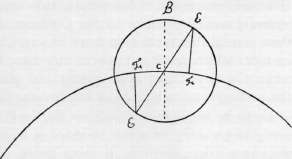
The Annuall difference is by the Inclination of Axes, or the Earths rolling [sidewise] in some part of the Eccliptick: Thus the Copernicans Solve it; but whether the Earths Center of Gravity some way Distant from the Center of its Magnitude do not somthing Contribute to this Unequall, and Wabling motion of the Earth may be worth our farthar Consideration, and thus much of tides and their Varieties.
[2.] The Other part of Water is fountains, or Springs, and rivers made up of many of them. Of these Consider the Causes, and the Kinds.
1. The Causes concurrunt to their production are the Sea, Rocky caverns of the Earth, Subterraneal fermentations or heats and Superficial moisture by [raynes].
1. The Only Material Cause Seams to be sea-water soaking into the Earth, which meeting with some Nitro-sulphurious minerals causeth
2. fermentations, Ebullitions, or heat[s], (Call’d Subterraneous fires) Such as are producted by cold water cast upon unslaked lime whence [Steams] do arise into
3. The Caverns of the Earth, and Clefts of the Rocks which are the Internall constituents of Mountains, Hills and all riseing Grounds; those Steam[s] condensed again by the Coldness of the Stone (in the Rock) these natural allimbecks drop down in water, and many drops make little currunts which break out where they can. Hence it is that hilly and rocky Countryes have most springs, and plain flates, have them some feet underground soaking every way into the Gravel: [34] If the Caverns, or Clefts be ample in one place, or the flacks of s[t]one lye to one way, then the Quantity of water collected is Sufficient to break out at one place in a living, Boylling, Bubling Spring. But if otherwise, and there be a Multitude of Small Crevises Seperated one from the other then will many small springs creep through a little Gravell at the bottom of the Hill under the surface of the flates beneath, and Swell them into Boggs. Therfore note the Cure of those Boggs is to cut off those Springs by opening a trench at the foot of the hill Just between the Wett, and the Dry.
4. That Raine hath some Influence on springs is manifest [by] scripture, and Experience; for they fail by Greater Droughts (1 Kings, 17. 7.) and after a Wett winter fountaynes break up plentifully in the Spring; but this not from a Supply of water, for Columella7 affirms that no rain sinks [below] 10 foot under Ground, whereas fountains come from the Deep, as is manifest in mines; Tis therefore by making a convenient lute, or perhaps a refrigitory, for those natural Alimbecks whereby [the Steams] are kept from Evaporating and the Suns heat kept [off] from hindring their Condensation; Else the pores of the Earth being opened the [Steams] would Get away and become matter of rain; hence after long droughts springs are low, and (Rain filling the Superficial Crevises) they are recruited again.
2. The Kinds of fountains are simple, or compound.
1. Simple fountains, or fresh are those whose waters are Clean seperated from the sea-salt, and all other tinctures, [or] inquinations, this is done partly by percolation, and partly by Distillation.
1. Percolation, or Streigning through the Earth Cheifly through those Earths [that] are most proper for the purpose, as Chalk, Ashes, etc:
N.B. Tis of great concern to our health if the waters which Supply our houses be Good and wholsome, the best be Smooth, light, without Smell, tast, or Collour; Such will laver well with Soap, and cause your spittle dropt upon it presently to spread abroad, and not continue togather, ’twill brew manyfestly better than other water, ’twill boyle pease Soft, and beaff without blackness or redness, and feels smooth, and not harsh when you wash your hands with it.
2. Distillation, as in [that] Elevation of [steams] (before mentioned,) for thereby the salt (being heavyer, than water) abides below; and that the rather for that it needs longer fermentation, to make it volatile and apt for Elevation. Hence it is that distilling in an Alymbeck will drop fresh water from Urine, and from sea water if it hath som time in putrefaction, whereby the parts are more apt to seperate. And this is also manyfest [in] the making or gathering of salt by the Evaporating of water.
N.B. Possibly by these things well considered may be found an Expedient (hereafter) for fresh water to be had at sea, either by some precipitating matter put into the water; (as was said to be done [in] Holland) or by a convenient way of distillation (as of late is proposed here in England)8 or perhaps [rather] by an upward percolation through matter apt to seperate, and retain the salt, the Water being before prepared by a due fermentation. An Offer unto such an Experiment may be this: Suppose a Cask filled with pipes which are stuffed with such percolating matter, and the Vessel Capable of a Good Quantity of such putrifyed Salt water as to float above the top of the first pipe tis then supposed the water will enter [by] the open End of the first pipe (a.) and then discend to (b.) then ascend to (c.) discend to (d.) ascend to (e.) discend to (f.) etc: Until it come to fall out at the cock (K.) into the bucket for Use. Now you must observe that ½ the Water in the pipe discends, and these effect little, or Nothing, because Salt in fluor will discend wherever the water can; but the other ½ that ascends must do the business. Note there may be many of these pipes contrived to stand in [one, or more] hogsheads, whereby you may have what height of Ascent will be needfull: The percolating material may be Ashes depauperated of its salt, and the pump of the ship may supply the first vessel with putrified salt water that lyes under the hold at the Keell.
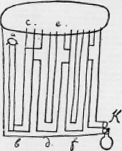
2. Compound, or Mixt fountains are such as running through some veins that [are] mineral take a tincture or Impregnation from them such as the hot baths purging [and] salt springs etc: The Quantity of the Impregnation may be discerned by the sea Glass carricks (of which before)
N.B. In Case your ordinary pump water be a little harsh, and have somthing of mineral taint tis Good to Save it in some wooden vessels, and let it stand 2 or 3 dayes before you Use it for thereby the saline and mineral mixtures will in good measure precipitate to the bottom, and So much for water. [35]

